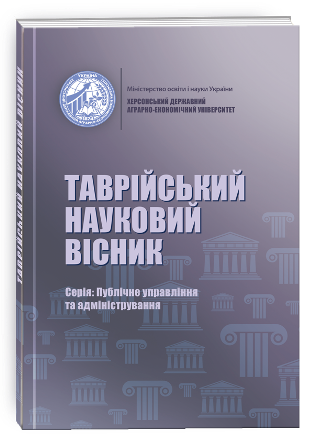PRACTICAL IMPLEMENTATION OF THE MODEL FOR ASSESSING THE READINESS OF UNITED TERRITORIAL COMMUNITIES TO IMPLEMENT PROJECT ACTIVITIES
DOI:
https://doi.org/10.32851/tnv-pub.2022.4.1Keywords:
project activity, community readiness, financial capacity, human capacity, fuzzy sets method, project management tools.Abstract
The article justifies the practical implementation of the model of assessing the readiness of united territorial communities to implement project activities. The factors influencing the implementation of project management and project activities are highlighted. It is emphasized that the methodological support for determining the readiness of united territorial communities for project activities involves building an appropriate assessment model using the fuzzy set method. It is determined that the input parameters of the fuzzy inference system are 4 fuzzy linguistic variables: financial capacity to implement project activities; staff capacity to implement project activities; organizational support of project activities; technological support of project activities. The output parameter is the linguistic variable "level of readiness of the territorial communities for project activities". It is substantiated that the level of readiness of amalgamated territorial communities for project activities reflects the extent to which: the territorial community is financially capable of implementing project activities; members of the territorial community are ready to implement project activities; institutional and organizational support is complete, which provides a set of powers and resources that the territorial community has to implement project actions and activities; technological support is appropriate, according to which there is a material and technical base, openness of information and communication, and openness of the information system. It is proved that the proposed methodological support for determining the readiness of amalgamated territorial communities for project activities allows not only to determine the level of community readiness in each area (financial capacity to implement project activities; staff capacity to implement project activities; organizational support for project activities; technological support for project activities), but also to give a generalized assessment using the method of fuzzy sets. The peculiarity of the obtained model is its ability to identify the level of preparedness of the community for the implementation of project activities, to identify weaknesses and significant deviations in the work, as well as to develop further actions to implement project changes.
References
Безпалько О.В. Соціальне проєктування. К. : Знання, 2010. 127 с.
Василюк О. Д., Фурса М. В. Кадрове забезпечення спроможності об’єднаних територіальних громад: до понятійного визначення проблеми // Демократичне врядування : вісник ЛРІДУ НАДУ. 2018. Вип. 22.
Васильченко Г., Парасюк І., Єременко Н. Планування розвитку територіальних громад. Київ : Ві Ен Ей, 2015. 256 с.
Дурман О. Л. Використання проєктного менеджменту в діяльності органів місцевого самоврядування. Вісник Херсонського національного технічного університету. 2020. № 3 (74). С. 140–147.
Мінаєва Г. М. Управління проєктною діяльністю органами місцевого самоврядування для зміцнення інфраструктури території. Теорія та практика державного управління. 2011. №3. С. 373–379.
Полянська А., Запухляк І. Проєктна діяльність як інструмент розвитку територіальних громад. Університетські наукові записки. 2021. № 1 (79). С. 160–170.
Русякова М.С. Обзор современных моделей оценки зрелости управления проектами. Молодой ученый. 2014. № 11. С. 230–236 8. Удод Є. Г. Проєктний підхід щодо підсилення спроможності територіальних громад в умовах децентралізації. Аспекти публічного управління. 2015. № 4. С. 6–13.
Успішна територіальна громада: будуємо разом / Бриль М., Врублевський О., Данчева О., Сеїтосманов А., Чубаров Е. Харків : Видавничий будинок Фактор, 2018. 128 с.







